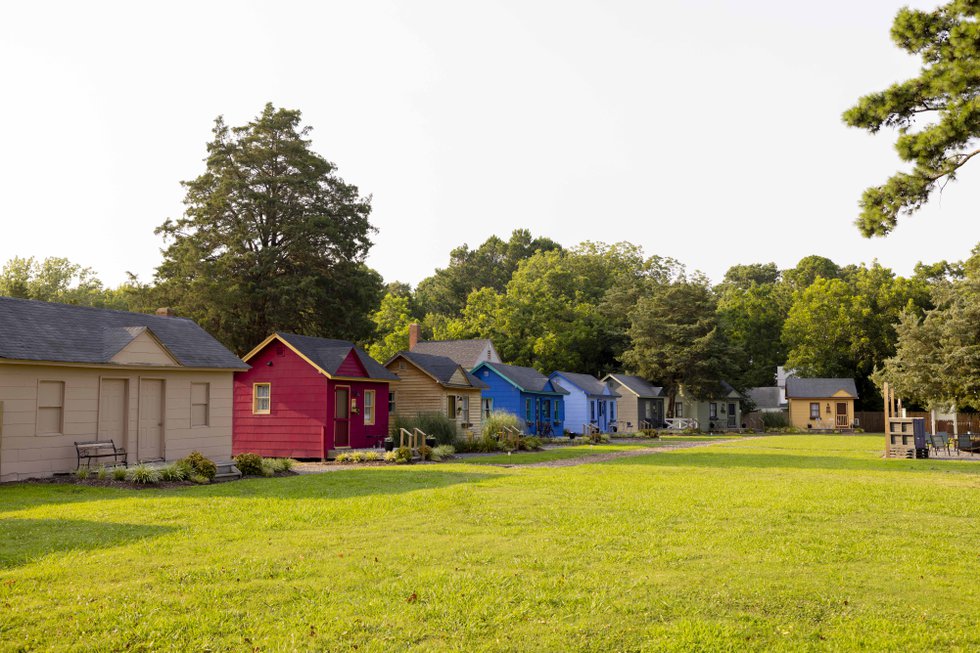It started with a vision board and a prayer, says Cape Charles resident Eric Hawkins, 53. He and his wife, Sylvia, 60, had been dreaming of creating a unique lodging destination for a long time. The couple put a photo of a tiny house village on their fridge and waited.
Eric also prayed: “Lord, help me see what other people can’t.”
The Hawkinses have been fans of the tiny lifestyle for more than a decade. They moved into a camper with their three kids in 2012 and started a short-term rental business in 2016, while also running Eric’s Virginia Beach-based HVAC company. “We’d already been living tiny,” Eric says. “We loved it.”
Fast forward to 2021—Eric and Sylvia were en route to Cape Charles, a place they loved to visit. For some inexplicable reason, instead of turning left toward town, Eric turned right onto Business Route 13.
All of a sudden, Sylvia says, “This is it! Stop the car!” Eric pulled over and looked to see what Sylvia was all excited about. Across the street was an overgrown lot with dilapidated tiny houses, barely visible amid a thick copse of cedar trees, recalls Eric.
The couple looked at each other and smiled. “The prayer came true,” Eric says. Then he let loose a laugh. “But it took a lot of hard work and sweat to make the vision come true!”
When the Fun Started
Today, Cape Charles Tiny Livin is an oasis of charm. Surrounded by rural landscape, the tiny house hotel with its bright colors and beautifully landscaped grounds looks organic, as if it’s always been here.
In fact, the buildings date to the 1930s, when the Esso Park Auto Court was built to accommodate hunters, fishermen, and travelers exploring the Shore in their new cars. Later, the property housed migratory workers. In 2021, when the Hawkins discovered them, the tiny houses had been abandoned for 45 years and were literally falling to pieces.
“That’s when the fun started,” Eric says. First, the couple cleared the land
of trees and undergrowth. Then they tackled the houses: rebuilding needed infrastructure, painting, furnishing,
and decorating—one tiny house at a time.
He and Sylvia would come up with ideas in the middle of the night. “It was almost like the houses whispered to me, ‘This is how I want to look,’” Sylvia explains. “Before we did anything, I laid out a map. I drew the houses and gave them names.”
“Each home took two to three months to complete,” says Eric. “We kinda took our time.” He recalls spray painting the houses, and “the old wood just sucked it up.”
Local townspeople came by, often dropping off vegetables, eggs, and even fresh seafood. “They were excited to see something happen,” Eric says. “People would tell us, ‘If you need anything, let us know.’ They appreciated what we were doing.”
To Each His (or Her) Own
Eight houses—Stay Awhile, Milk and its twin, Honey, Fisherman, The Barn, Mermaid, Vintage, and the Red House—have been totally renovated with two more in the planning stage, plus four foundations on which they’ll build tiny houses from scratch. All homes have kitchenettes and ensuite bathrooms.
My husband and I stayed in Stay Awhile and loved the ambiance. Think light and bright with lots of wood and a comfy vibe. Everything we needed was provided, and the chairs on the front porch were perfect for watching the sun set.
Wherever possible, the couple used repurposed materials as they renovated the houses. The Barn, for example, which is the only two-story house, features wood Eric intercepted on its way to the dump. “It’s from a house from the 1800s,” he says. The ladder up to the second floor is also original to the barn that was on property.
Downstairs, there’s a sitting area, a dining table, kitchenette, and lots of windows. The floor is a work of art, composed of cement and granite pieces in various geometric shapes. Upstairs,
rustic wood lines the walls of the bedroom
furnished with a king-sized bed. To maintain the character of the original barn, Eric left exposed beams throughout. I love the way it smells inside, like my grandmother’s attic.
Every tiny house is unique, but my favorite is Vintage. When you enter, you are surrounded by relics of yesteryear: an old-timey fridge and TV console (with a modern flat screen inside), a four-poster bed topped with a sheer voile canopy, even an old-fashioned window unit. The exterior is natural wood. “It had layers and layers of paint,” Eric recalls, “but Sylvia wanted me to take it down to the original wood.”
The Red House is for adventurous guests, with photos of Jimi Hendrix on the walls and ceiling, along with mirrors, and a pole for pole dancing! I love the floor, which Sylvia painted by scattering paint in every color of the rainbow and then spreading it with a rake. It looks like a psychedelic spider web.
Besides the tiny houses, which can accommodate up to 22 overnight guests in total, Eric and Sylvia offer a wedding venue for small wedding parties (up to 80 people) as well as elopements. As a backdrop for wedding vows, the couple fashioned an old shed into a greenhouse full
of plants, which are a passion of Sylvia’s. The roof
is partially topped with transparent plastic panels, giving the greenhouse a bright, airy feel.
Eric and Sylvia welcomed their first guests in Jan. 2022. They originally predicted Cape Charles Tiny Livin would attract a lot of millennials, but they’ve been surprised to see more folks in the
45+ range. “It brings them back to Memory Lane,” says Eric.
As we sat around the firepit at day’s end, Eric told a story about a guest who heard him say he wanted to make the screen doors close more quietly. “The guest said, ‘Please don’t. The slamming screen door takes me back to my childhood.’” Eric happily complied.
Rates start at $168 per night. CapeCharlesTinyLivin.com










